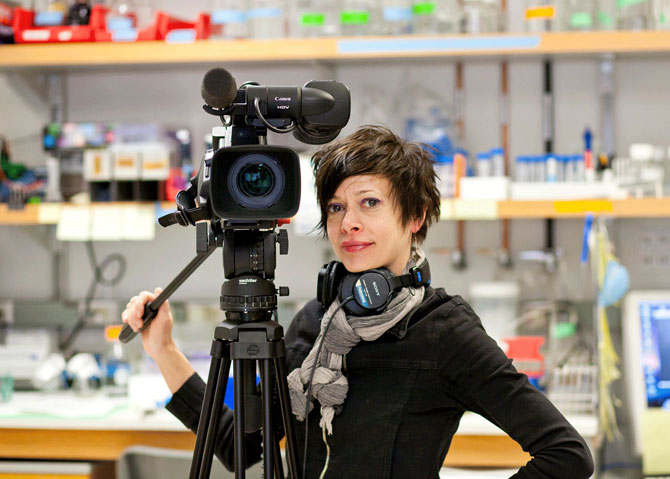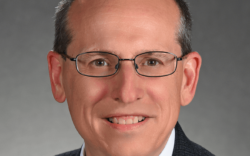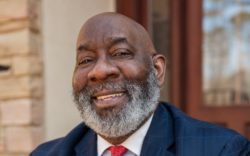Kappa Alpha is a University of Georgia fraternity founded in the image of Robert E. Lee. Its members, as recently as a decade ago, would ride horses down Lumpkin Street dressed as Confederate officers. So, of course, residents of the historically African American Hancock Avenue/Reese Street area just west of downtown were mystified and angry when KA bought property in their midst for a new fraternity house in 2006.
Danielle Beverly, a filmmaker currently based in Brooklyn, spent more than three years living in Athens and documenting the conflict, which, in addition to the usual town-gown problems like parking and partying, dredged up issues of race and class that, sadly, have become even more relevant due to the Charleston, SC, shootings and renewed debate over the Confederate flag. The finished product, Old South, is screening Thursday, July 23 at Hill First Baptist Church, the center of the fight against the KA house. Beverly recently spoke to Flagpole about making the film, as well as racial divisions and gentrification in Athens.
Flagpole: How did you first hear about this story, and what drew you to it?
Danielle Beverly: When I found out about the story, I was living in California. I knew I was ready to make my next feature-length documentary. I shoot these films by myself, and that’s by design. I feel that it’s really important to be able to gain intimate trust with those in front of the camera, and that’s more difficult to do when you have a crew with you.
I heard about the story pretty quickly after Kappa Alpha had decided to move into the neighborhood and begin building their fraternity home there. A person I know in Athens said, ‘You may want to come down here and check this out.’
So I flew there and spent four days researching and checking out the neighborhood. Everyone said, ‘The person you need to talk to is Hope Iglehart.’ I kept leaving messages for her. On the very last day I was to be there, she said, ‘I’m sorry, I’ve been busy. Please come by my funeral home, and we can talk.’
I walked in, and here she is, this 30-year-old woman who’s taking on her family business. She’s a fifth-generation funeral director. And she’s sitting underneath this portrait of her grandfather, who started the funeral home. And I thought, ‘This woman has a lot on her shoulders. She’s a spokeswoman for the fight against the fraternity. It’s her mother’s home, her family home, that the fraternity’s moving next to. Meanwhile, they’ve knocked over all the other houses on the block. This is the person who needs to be in front of the camera.’
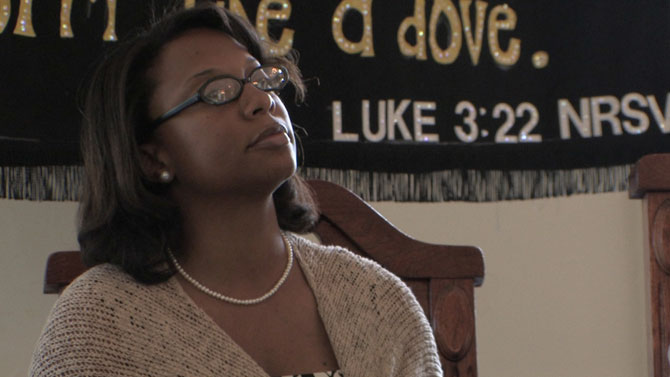
Hope Iglehart as depicted in Old South.
FP: Who else did you speak to?
DB: Oh, I spoke to a lot of people. You really have to think about who has the most at stake. Who is it going to affect the most? So I started going to Hill First Baptist Church.
I’m so proud to bring the film back to Athens, and I’ve always thought it should be shown on the grounds of Hill First Baptist Church. They are a 150-year-old historic black church, and they were the Ground Zero for the resistance against the fraternity. By the end of the story, they have become a change agent, and they have also become the grounds for reconciliation. Like many churches, they are the pillar of the community, but they are also a place where you can make social change, and you can experience healing.
There are two other people who emerge in the film, one of whom was a complete surprise. That’s the beauty of documentary filmmaking—you have no idea what’s going to happen. About halfway through filming, a couple of years in, I met Karen Witten, who started a community garden and became an important voice in the film. The third character was from the fraternity.
I’ve always been interested in who they were, but I’m not a journalist. Documentaries are not interviews. Documentaries are witnessing, at least the way I make them.
FP: So this is not a talking-head type of documentary.
DB: Exactly. It was clear who I was aligned with. Who is in a position of power in this situation? The fraternity, or the neighborhood that’s being gentrified? I knew [KA] would emerge into the story at some point, but I wasn’t eager to push that dynamic. I was waiting for the organic moment where they would walk right into the story.
Thankfully, a young man who was vice president of the fraternity at the time becomes involved in a community effort, and he becomes the person who is the eyes, ears, face and voice of the fraternity and their experience. I’m happy to say that, while I don’t necessarily agree with everything that fraternity represents, I do respect this young man greatly, especially the trust he provided me.
FP: Was the Old South background of the fraternity the bigger issue, or was it gentrification?
DB: It would depend on who you’re asking. Do I think the gentrification issue was real? Sure, but I think to say it’s the main issue is to let the racial issue off the hook. That is the much bigger issue, and I think it was incredibly hurtful to the black community. How those issues played out in a very violent way in Charleston, SC, there are a lot of similarities: A historic black church, a young man who’s part of a group that’s been known to fly the Confederate flag. It’s a much different outcome, I’m happy to say. It’s one of healing and reflection. Some crucial steps forward were taken by both groups. There was no violence, thankfully.
FP: People who wave the Confederate flag don’t always realize how it appears to other people. How did the attitude of the KAs change when they met the residents and heard their concerns?
DB: I can’t speak for the KAs, because I worked with one young man who organically walked into the story. Fraternities do community service. That’s part of their mandate. As one audience member said, ‘We do community service to make up for all the bad things we do on the weekends.’ This young man who’s in the film is really committed to the project he initiates.
But that’s not the question I was asking. I was witnessing and hoping there’d be some positive change, and there was. I do think both sides came a little bit closer to each other. What I hope this non-judgemental film offers is an understanding of what it’s like to walk in someone else’s shoes.
I think the fraternity was stunned that the black community would take issue with them moving into the neighborhood. You don’t join a fraternity that has an antebellum parade and not consider that that’s a hurtful thing. You’re either that naive, or your eyes are open, and I think everyone’s eyes are open now.
They had a version of the Confederate flag flying outside their old house, and you can see it in the film. They did not fly anything outside their house when they moved into the neighborhood. There is a cannon in the yard. They still had an antebellum parade every year. Apparently this year there are no hoop skirts, but what does that really mean? Does it mean the organization is considering that what they traditionally stood for is hurtful, or does it mean they’re just taking it behind closed doors? I don’t know.
FP: They still do the parade? I guess they just got rid of the gray uniforms and the horses.
DB: They take away little things each year, but it’s because of pressure. I call it fighting for your right to be insensitive. But again, I really want to emphasize that I care very much about everyone in front of the camera. It doesn’t mean I’m a KA supporter, but I do look at each person in their entirety.
FP: Did you document changing attitudes in the African American community? Did they become more accepting of the fraternity?
DB: I think you and your audience should come and see the film, because the film ends in [Hill First Baptist Church]. The final scene is Kappa Alpha, Hope Iglehart and several community members. The film ends with a greater understanding of each other, with reconciliation and a step forward for both communities.
You know what it’s like living in Athens. It’s a very divided town. I also think there’s a need and a want to be friendly with one another and friendly with all people in the town you live in. Church communities are by their nature that way. Frankly, Hill First Baptist Church and its grounds are in 50 percent of the film.
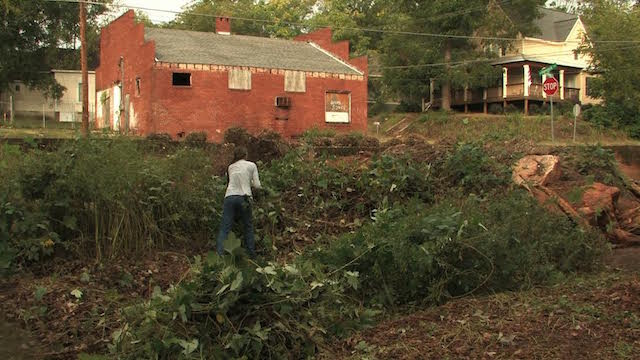
Photo Credit: Danielle Beverly
Clearing kudzu for the community garden near Hill First Baptist Church.
FP: Tell me more about the community garden at the church that’s featured in the film.
DB: When you live in a neighborhood where you’re filming, it’s not like parachuting in. I’m walking home from a couple blocks away with my camera, and I see on the grounds at Hill First Baptist Church this woman who is pulling kudzu by hand—a white woman, older, who I’ve never seen at the church, and she’s doing this Sisyphean task. It was so cinematic, I had to film it.
It turns out that she’s been planting a garden there. Ray and Karen [Witten] came to Athens to retire and become involved in what they thought was a very diverse community. Karen was at the Atlanta premiere, and she shared in a Q&A with the audience that Athens is a very racially divided community. This community garden ended up being an agent of change for the neighborhood.
The gentrification had started by then. The park on the corner [Reese and Pope Park] that you see early in the film was an older park, primarily used by black residents, old and young, then became gentrified, upgraded. It didn’t make it into the film, a meeting for that process. The fraternity has kicked in the door for gentrification, but it’s important to note, the black community got activated at that time, and they fought for historic designation.
Now, the fraternity was already there. They had snuck their plans in, so that’s getting built. But that doesn’t mean the neighborhood wants more fraternities, huge housing, huge buildings that are going to change the character of the neighborhood and ultimately cause problems.
They did an extensive amount of research. Hope gave me the documentation after they were done, and it’s the size of a phone book from New York in the ‘60s. There were going to be no more large structures there because of this organized activism by the community.
Also, though, people started selling [their homes], and it’s a much different place now. That’s also in the film—you see the change in the park, and the fraternity’s now the ones using the basketball court, houses are selling, and new ones are being built.
FP: That all started before the fraternity was built, though.
DB: It definitely was a way of saying, ‘College students, now this is your neighborhood, too.’ Not just a rental house here and there, but an entire block, except for Hope’s mother’s house.
FP: Also, the Hancock-Reese neighborhood formed a partnership with Cobbham, which is a very different, white, affluent neighborhood nearby that was also fighting off fraternities and dealing with students for a long time as well.
DB: Yeah! There was a small group of people early on who were working with the Reese neighborhood to mobilize them or help them in their organizing efforts. You’ll see early in the film people in Cobbham or on the edge of the Reese neighborhood in the church going for the historic designation.
But again, this is a black community, taking their community into their own hands and going up against the government. You have to prove to the municipality that this is worthy of their [declaring] it historic.
FP: You must have had so much footage. How did you decide what to use, and is there anything you regret leaving out?
DB: There’s one scene I left out that we tried finding the right spot for probably 50 times, and it’s my absolute favorite scene in the film. It’s with Thelma Hurley, who’s Hope’s grandmother, was the principal at the black school, was everybody’s teacher in the black community, and she just died within the last month. This film is a valentine to Thelma Hurley.
WHAT: Old South
WHERE: Hill First Baptist Church garden, 205 N. Pope St. (Bring a chair or blanket.)
WHEN: Thursday, July 23, 9 p.m.
HOW MUCH: FREE!
Like what you just read? Support Flagpole by making a donation today. Every dollar you give helps fund our ongoing mission to provide Athens with quality, independent journalism.




